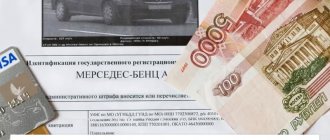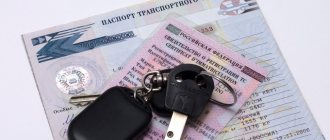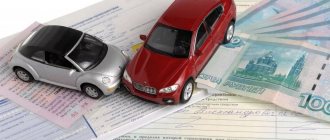What is it, what articles of the Civil Code of the Russian Federation is it regulated?
Reference. Ownership of a vehicle is a real right that gives its owner the opportunity to freely dispose of the vehicle, including transferring it to third parties under an agreement.
In the Russian Federation there are the following forms of ownership:
- state federal;
- state regional;
- public organizations;
- private.
Based on numerical characteristics, individual, public and group property is distinguished.
Legislative regulation of ownership of a vehicle and its transfer is based on Art. 218, 223, 224 and 235 of the Civil Code of the Russian Federation.
Owner and owner of transport - what is the difference?
The owner of the vehicle is the person whose data is reflected in the title. The owner is considered to be a person who legally controls the vehicle, for example, by power of attorney or by lease. It is the owner who is responsible for damage caused in the event of an accident.
At what age can you become the owner of a car? Can you have a minor child?
Civil legislation does not provide for age restrictions regarding vehicle owners.
In accordance with the administrative regulations “On the procedure for registering motor vehicles,” if a car is registered in the name of a person under the age of 14, a guardian or parent must act as an official representative. The interests of the child can be represented by another person who has confirmed his status in writing.
Persons over 14 years of age can apply for a vehicle themselves if they have written permission from their parents or guardians. It is important to remember that minors are prohibited from driving.
When this moment of transition occurs, what does it mean?
Transfer of ownership of a vehicle is the transfer of rights and obligations associated with the vehicle to another person. According to Art. 223 of the Civil Code of the Russian Federation, this right begins from the moment when the property passes into the ownership of another person, unless otherwise provided by law or agreement. As stated in Part 2 of Art. 218 of the Civil Code of the Russian Federation, the basis for the transfer of ownership of a thing is a purchase and sale agreement.
What confirms the occurrence of this moment?
Important! The main title document for a car is the vehicle passport (PTS). If the car is new, you can get it from the manufacturer, supplier or customs authorities.
To confirm the transfer of rights to a used car, a notarized sales contract is drawn up, and the title is provided by the seller.
In addition, the owner must have a compulsory motor liability insurance policy and a vehicle registration certificate in case of a traffic police inspection.
The car's license plates are entered into the database indicating the owner. Only after completing the registration procedure can you become a full owner.
In what cases should recognition be sought?
Recognition of ownership of a car is carried out by court order in the following cases:
- legacy transport section;
- loss of title documentation;
- division of property during divorce.
In addition, this procedure often accompanies transactions:
- purchase and sale;
- donations;
- exchange.
The need for it arises in the absence of important parts of the legal process.
A claim for recognition of property rights will be accepted only if the need to resolve the issue with the participation of judicial authorities becomes obvious.
How to transfer a car to a new owner?
The procedure is carried out at MREO and consists of several stages:
- Collection of documents specified in clause 15 of Order No. 605 of the Ministry of Internal Affairs of Russia.
- Visit to the registration office of the traffic police with a package of papers and an application for registration.
- Passing a vehicle inspection.
- Payment of state duty.
- Receiving new documents.
Reference! According to the regulations of the Ministry of Internal Affairs, which came into force in 2013, in order to re-register a car to another owner, it is not necessary to deregister the vehicle.
conclusions
Ownership of a car arises after its transfer to the new owner of the property. Or from the moment provided for by the signed agreement. By remembering these 2 rules, you can easily understand when a person becomes a full-fledged owner of transport.
What to do when it comes to inheritance? In this case, the person becomes the owner of the car after inheriting. The notary will issue a document on the basis of which it will be possible to issue a certificate of ownership, as well as re-register with the traffic police.
In some sales contracts you can often find a clause according to which the car becomes the property of the new owner only after the object is registered with the State Traffic Inspectorate. Such an agreement is legally illiterate. After all, without title documents, it will not be possible to register a car with the traffic police with information about the new owner. Accordingly, such an agreement is either considered illegal, or it provides ownership rights after its conclusion and transfer of the car for use to the buyer.
It's actually simple. Ownership of a car arises from the moment provided for in the purchase and sale agreement. Or, as we have already said, after transferring the car to the new owner for use.
Legal powers and responsibilities
According to legislative act No. 283-FZ dated 08/03/2018 (as amended on 07/30/2019), the owner of the vehicle has the right to:
- Carrying out state registration of a car. In this case, the choice of the traffic police department for entering data into the database can be made regardless of the applicant’s place of registration.
- Preservation of the number assigned to the vehicle, as well as its transfer upon sale or donation. The new owner can accept the car with the existing number or replace it.
- Obtaining registration marks that correspond to the state standard on the basis of clause 5. No. 256-FZ of July 30, 2019.
Along with rights come obligations:
- Within 10 days from the date of receipt of a vehicle that was not previously registered, you must go through the registration procedure. The same period is given for filing an application for a change of owner and making appropriate changes to the registration data.
- Independently visit the organization that produces registration plates to obtain them.
- Contact the registration department to perform other actions provided for in Art. 10 No. 283-FZ, for example, to restore a lost or deteriorated vehicle title.
- If necessary, provide the registration department with a vehicle for inspection.
- Pay transport tax on time.
Civil liability of the vehicle owner, also in case of an accident
The owner of a car who causes harm to others bears civil liability for this.
Damage must be compensated without fail, except for the following cases:
- the impact of a natural disaster or other force beyond control;
- damage caused by an unknown person;
- the cause of the damage was the malicious intent of the victim.
According to Art. 1079 of the Civil Code of the Russian Federation, a car is a source of increased danger, therefore the owner of the vehicle must compensate for the damage, even if it is proven that he was not involved in this situation.
For example, if a driver, in order to avoid hitting a pedestrian, is involved in an accident in which passengers are injured, he must first pay compensation to the victims and only then try to press charges against the pedestrian.
According to the Civil Code of the Russian Federation, mandatory compensation is subject to:
- moral injury;
- damage caused to property;
- harm to health.
Important. As stated in Art. 1083 of the Civil Code of the Russian Federation, if the victim committed negligence, due to which the harm caused to him increased, the amount of compensation payment will be reduced. In addition, the justice authorities must take into account the financial situation of the perpetrator.
What powers can be transferred to a third party by power of attorney?
The owner of the vehicle can transfer the following rights to the vehicle to third parties:
- order of the vehicle;
- passing a technical inspection;
- receiving a vehicle from the impound lot;
- registration of an insurance policy;
- registration of vehicles with the traffic police;
- obtaining a duplicate license plate number.
If third parties plan to complete a purchase and sale transaction, appear in court or travel abroad, the power of attorney should be certified by a notary. In other cases, it is enough to present a handwritten form of the document.
The right to drive a car in accordance with clause 2.1.1 of the Traffic Regulations is transferred without drawing up a power of attorney. Upon request, the driver will be required to present a package of documents for the vehicle and valid insurance.
Cost of owning a vehicle
When purchasing a car, many people do not think about the costs of its operation. The total amount depends on the make, model of the vehicle and region, and is calculated based on the following indicators:
- Loss of value after 3 years of use.
- Interest if the car was borrowed.
- Taxes and fees, including those necessary for registering a vehicle with the traffic police.
- Fuel.
- Insurance.
- Technical inspections.
- Other expenses: car wash, tire replacement.
Owner/proprietor. How roles and responsibilities are distributed. ¦ Road accident ¦ Communication with the traffic police
https://www.pdd-razbor.ru/frame.php?doc=problems/vladelec_sobstv.php
In everyday life, we are accustomed to equating the concepts of “owner” and “owner”. Those. the owner is the owner. However, who then is the person driving the car by proxy?
Also the owner. More precisely, it is he who at this moment is the owner of the vehicle, since these rights have been transferred
owner.
Let's try to figure it out.
In accordance with paragraph 1 of Article 209 of the Civil Code, the owner has the rights to own, use and dispose of his property.
Possession
means the ability to actually have, physically possess some property at the moment.
Right of use
means the possibility of using this property, extracting its useful qualities, consuming it (in fact, this is only possible by owning it).
Order
means the ability to determine the fate of property (sell, donate, destroy).
However, in accordance with paragraph 2 of Article 209 of the Civil Code, the owner has the right to transfer all these powers (one, two or all together) to another person. The issuance of a power of attorney containing a list of rights granted confirms their transfer. In this case, the owner remains the owner, but is obviously deprived of the opportunity to use this property from the moment of its transfer. The powers transferred by the owner will now belong not to him, but to the new legal owner - the owner by proxy.
Of course, it is necessary to distinguish between legal and illegal possession. Illegal possession does not give any powers, but it entails a considerable burden of responsibility.
So, by the owner of a vehicle we mean its legal owner, who is currently using it in his own interests (this is indirectly confirmed by the 2nd paragraph of paragraph 1 of Article 1079 of the Civil Code of the Russian Federation).
Now let's deal with responsibility
As we understand it, it can be administrative, civil and criminal.
With liability for violation of traffic rules ( administrative
) everything is simple -
the subjects
of the offenses are clearly
indicated in the wording
of the corresponding offense (in the Administrative Code).
These can be either the owners or owners of the vehicle by proxy, or persons driving the car in the presence of the owner/owner by proxy*. In other words, in most cases the driver is responsible, i.e. person driving a car.
——————————————-
*or other special right (rent, freight, order of the relevant official, for example, provision of a car by the employer)
In some cases, a person who is not a driver, but is the owner or possessor of a car by proxy*, may also be brought to administrative liability (for example, when transferring control of a vehicle to a person who obviously does not have the right to drive).
From criminal
Responsibility is also simple - it is borne by the guilty driver (whoever is driving is the one to blame).
Civil responsibility
The issue of liability for damage caused to the property of a citizen/legal entity and the health of a citizen is resolved differently.
As a general rule, damage caused is compensated by the causer, unless the latter proves the absence of his guilt.
If harm is caused by a source of increased danger, then the harm is subject to compensation by its owner or possessor, regardless of his guilt. The only way for a vehicle owner to avoid liability is to prove that the damage was caused as a result of force majeure or the intent of the victim (clause 1 of Article 1083 of the Civil Code).
(Article 1079 of the Civil Code also includes a car)
Analyzing Article 1079 of the Civil Code, the following conclusions can be drawn.
The owner who does not own the car at the time of causing the damage is not liable for the damage if the car was driven by a person to whom the owner, on any legal basis, entrusted the control of the car.
If the owner
drove his own car and caused harm to someone, then he will be held accountable for the harm caused. This is the simplest case; however, there are some exceptions (employee, minor), which are discussed below.
If the car was not driven by the owner,
and the owner of the car did not transfer the driving rights to him, then
the owner himself will be responsible,
unless he proves that the vehicle left his possession
against his will.
For example, in the event of a car theft, it is necessary to immediately report it to law enforcement agencies or present relevant witnesses.
In this case, the person who unlawfully took possession of the vehicle is equal
in relation to liability for damage caused to the owner of the car.
This issue should not be taken lightly. The court will look very skeptically at the owner of a car that hit a person, and the owner claims it was stolen after the accident.
But in the event that it is established in court that such unlawful taking is the fault of the owner
, then he can assign part of the responsibility to him. For example, if the owner runs into the store “for a minute” without turning off the engine and leaving the car doors unlocked, and the thief takes advantage of this.
If a person drives a car by proxy
in the absence of the owner, it will be the owner who is responsible.
However, if the owner
was in the same car, then it is considered that it did not leave his possession, and its owner will bear responsibility (if they hit a person - a crime is on the driver, damage to health is on the owner).
Owners of sources of increased danger jointly
bear responsibility for damage caused to third parties as a result of the interaction of these sources (collision of two/several vehicles)
Damage caused
as a result of the interaction of sources of increased danger
, their owners
are compensated by the culprit(s) of the incident, in proportion to the fault, i.e. on a general basis (Article 1064 of the Civil Code).
If a person drives a car (without own rights to own it) in the presence of
the owner or the person holding the power of attorney, the latter will be responsible.
When renting
a vehicle
without management and maintenance services
will be considered the owner (and responsible for damage) directly to the lessee.
However, if the vehicle lease agreement provides for the provision of management and maintenance
(i.e. this is a
charter
), then the vehicle is considered to remain in the possession of
the lessor.
If the car was driven by an employee,
and the owner of the car is his
employer,
then the employer will be responsible, regardless of whether the harm was caused during working hours, or whether the driver made a “left trip”, it is important that the employer himself entrusted this car to the employee. It’s another matter if the driver took the car for a ride without permission, but in this case the employer will have to prove this fact.
Restrictions
In some cases, the owner's rights to a vehicle may be limited. There are several types of encumbrances:
- Pledge. Used to ensure the borrower fulfills loan obligations. A citizen has the right to drive a vehicle, but transferring property to third parties is prohibited. After final settlement with the creditor, the owner can use the car again. If the money is not paid, the car is repossessed to pay off the debt.
- Arrest. Used to force the debtor to repay finances taken from the bank. In addition, this measure may be necessary to preserve the value of the property. The vehicle is withdrawn until the relationship between the lender and the borrower is resolved. An arrest can be made by the police, a court, or an organization executing a court order.
- Search. An encumbrance is imposed if the vehicle is included in the database of objects wanted by law enforcement agencies. In this case, it will not be possible to cross the border with it. Any interested person can find out that a car is wanted, so an attempt to sell such a car will most likely end up in a police station.
Important! Care should be taken to remove encumbrances before concluding a purchase and sale transaction. Otherwise, the vehicle will not be re-registered to the new owner.
The process of forming an act
If the owner is legal person, then the condition that you need to be in person in the office when drawing up the act also does not apply. However, the name of the owner must be indicated in the documentation. The citizen indicates information about himself as a person who has the authority to control a vehicle. It is this person who makes the payment and enters into an agreement with the insurance company representative.
Such a citizen is automatically included among those who will be covered under the insurance agreement. When the paper formation process takes place in the situation in question, it is not necessary for him to indicate his own name as someone who can drive the car. Any citizen has the right to apply for this act. It is necessary to take a power of attorney; it is not necessary that this act be certified using the proper method. You will need to contact a notary. The owner of the car has the right to issue a one-time power of attorney. There are also special and general types of powers of attorney. With any of them it will be possible to draw up the act in question.
ATTENTION !!! It is important to note that it is acceptable to use a handwritten document. It is also necessary to collect other documentation to formulate the act in question. This is a statement that reflects the request for insurance for the vehicle, as well as documentation of all persons authorized to use the vehicle.
It is also required to submit documents that verify the identity of both participants in the relationship. Papers are also provided for the machine. This is an STS and a passport. If an insurance contract has previously been concluded, it must also be submitted.
It will be necessary to additionally bring a power of attorney to the authorized organization indicating the existence of the right to draw up the act in question. It has been established that a citizen has the right to submit the listed acts in the form of copies. However, you need to find out about this opportunity directly from the company.
Grounds for termination
According to Art. 235 of the Civil Code of the Russian Federation, ownership rights are terminated in the following cases:
- upon alienation of the vehicle to third parties;
- in case of voluntary renunciation of property rights;
- when the car is destroyed;
- upon confiscation.
The basis for alienation is a contract of sale or donation. The obligations of the owner of the car cease only when the rights to it are transferred to another person.
This means that if there was an encumbrance on the scrapped vehicle, compensation will still have to be paid.
Problems and difficult questions
- What are the features of the transfer of ownership from an individual to a legal entity? The previous owner of the vehicle can give the buyer who purchases the car for the purpose of subsequent sale the authority to terminate the registration of the vehicle with the traffic police. These powers are specified in the agreement or power of attorney.
- If a duplicate car is discovered, what should the owner of the original do? Most often, drivers find out about the existence of a double car when they start receiving fines.
In this case, you should write a statement to the traffic police, mentioning your non-involvement. It will be necessary to prove that the car was in a different place at the time of the offense. Comparing the original vehicle with CCTV footage can also help. In difficult situations, you will have to order an examination. - Who bears the tax burden when selling a vehicle? The owner whose details are indicated in the PTS.
- Will the new owner have problems registering a vehicle that was confiscated before purchase? Traffic police officers can track the entire history of the car. If there is no prohibition on registration, there are no grounds for refusal to the new owner. In any case, it is recommended to ensure that there are no encumbrances before purchasing.
- How to find information about the owner of the vehicle? Knowing the license plate number of the car, you can contact the traffic police and get an extract from the database about this vehicle. But you can count on providing such information only in the following cases:
- The vehicle is blocking the exit from the parking lot;
the driver of the car, as well as the person wishing to obtain information about him, was involved in an accident.
- How to change owner details? You must submit an application through State Services or during a personal visit to the traffic police department. After this, you need to drive your car to the State Traffic Inspectorate. You must take with you a printed application form, a receipt confirming payment of the state fee, and original documents. Once the review is completed, changes will be made to the papers.
In addition, on the official website of the traffic police you can check the vehicle by VIN code. There is no specific information about the owner in such an extract, but you can find out his status - an individual or legal entity.
Ownership of a vehicle is regulated by law, so law enforcement agencies can easily determine who should control and be responsible for the vehicle. Having understood this issue, the buyer can be confident in the purity of the transaction and the legality of his actions.










